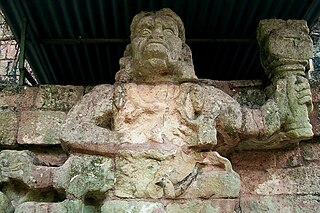
Copán is an archaeological site of the Maya civilization in the Copán Department of western Honduras, not far from the border with Guatemala. It was the capital city of a major Classic period kingdom from the 5th to 9th centuries AD. The city was in the extreme southeast of the Mesoamerican cultural region, on the frontier with the Isthmo-Colombian cultural region, and was almost surrounded by non-Maya peoples.
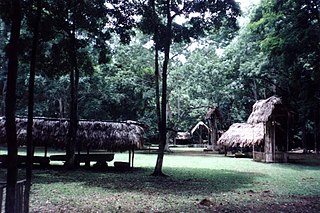
Dos Pilas is a Pre-Columbian site of the Maya civilization located in what is now the department of Petén, Guatemala. It dates to the Late Classic Period, being founded by an offshoot of the dynasty of the great city of Tikal in AD 629 in order to control trade routes in the Petexbatún region, particularly the Pasión River. In AD 648 Dos Pilas broke away from Tikal and became a vassal state of Calakmul, although the first two kings of Dos Pilas continued to use the same emblem glyph that Tikal did. It was a predator state from the beginning, conquering Itzan, Arroyo de Piedra and Tamarindito. Dos Pilas and a nearby city, Aguateca, eventually became the twin capitals of a single ruling dynasty. The kingdom as a whole has been named as the Petexbatun Kingdom, after Lake Petexbatún, a body of water draining into the Pasión River.
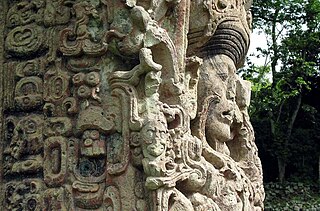
Uaxaclajuun Ubʼaah Kʼawiil, was the 13th ajaw or ruler of the powerful Maya polity associated with the site of Copán in modern Honduras. He ruled from January 2, 695, to May 3, 738.

Jasaw Chan Kʼawiil I also known as Ruler A, Ah Cacao and Sky Rain,, was an ajaw of the Maya city of Tikal. He took the throne on May 3, 682 and reigned until his death.

Yikʼin Chan Kʼawiil also known as Ruler B, Yaxkin Caan Chac and Sun Sky Rain,, was an ajaw of the Maya city of Tikal. He took the throne on December 8, 734.

Chak Tok Ichʼaak I also known as Great Paw, Great Jaguar Paw, and Toh Chak Ichʼak was an ajaw of the Maya city of Tikal. He took the throne on August 7, 360? and reigned until his death in 378, apparently at the hands of invaders from central Mexico.

Yax Nuun Ahiin II also known as Ruler C and Chitam,, was an ajaw of the Maya city of Tikal. He took the throne on December 25, 768 and reigning probably until his death. He was son of Yik'in Chan K'awiil and brother of 28th Ruler. The monuments associated with Yax Nuun Ahiin II are: Stelae 19, 21 and Altars 6 and 10.

During the 7th and 8th centuries in Mesoamerica, there was an evident shift in the roles women played in ancient Maya society as compared with the previous two centuries. It was during this time that there was a great deal of political complexity seen both in Maya royal houses as well as in the Maya area. Warfare was a significant factor in political competition and marriage was one of the ways that alliances were made between the different polities. This was accompanied by a shift in women's roles from wife and mother to playing integral parts in courtly life, such as participating in rituals involving the supernatural world and at times ruling individual polities.

Bʼalaj Chan Kʼawiil was a Maya ruler of Dos Pilas. He is also known as Ruler 1, Flint Sky God K and Malah Chan Kʼawil.
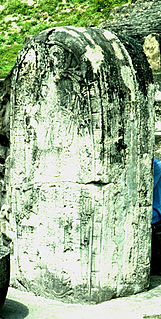
Jasaw Chan Kʼawiil II also known as Stela 11 Ruler,, was an ajaw of the Maya city of Tikal. He ruled c.869. The monuments associated with Jasaw Chan Kʼawiil II are: Stela 11 and Altar 11.

Sihyaj Chan Kʼawiil II, also known as Storm Sky and Manikin Cleft Sky, was an ajaw of the Maya city of Tikal. He took the throne on November 26, 411 and reigned until his death. He was a son of his predecessor Yax Nuun Ahiin I and Lady Kʼinich, and a grandson of Spearthrower Owl. Stela 31, erected during his reign, describes the death of his grandfather in 439; other monuments associated with Sihyaj Chan Kʼawiil II are Stelae 1 and possibly Stelae 28. Tikal Temple 33 was Sihyaj Chan Kʼawiil II's funerary pyramid and his tomb was located beneath it.

Not to be confused with Ajaw Bʼot, king of Seibal.
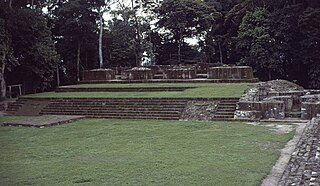
Sky Xul was a king (ajaw) of Maya city-state Quiriguá in Guatemala, who ruled 785 – c. 795.

Kʼakʼ Yipyaj Chan Kʼawiil was a ruler of the Mayan city of Copán. He was the son of Kʼakʼ Joplaj Chan Kʼawiil. The early period of his rulership fell within Copán's hiatus but later on he began a programme of renewal in an effort to recover from the earlier disaster of the city. He built a new version of Temple 26, with the Hieroglyphic Stairway being reinstalled on the new stairway and doubled in length. Five life-size statues of seated rulers were installed seated upon the stairway. Kʼakʼ Yipyaj Chan Kʼawiil died in the early 760s and is likely to have been interred in Temple 11, although the tomb has not yet been excavated.

Sihyaj Chan Kʼawiil I, was ajaw ("lord") of the Maya city-state of Tikal. He was son of his predecessor Animal Headdress and Lady Skull. The monument associated with Sihyaj Chan Kʼawiil I is El Encanto Stela I.

Kʼan Chitam, also known as Kan Boar and Kʼan Ak, was an ajaw of the Maya city of Tikal. He took the throne on August 8, 458. He was son of Sihyaj Chan Kʼawiil II and Lady Ahiin. The monuments associated with Kʼan Chitam are Stelae 2?, 9, 13 and 40.

Wak Chan Kʼawiil, also known as Double Bird, was an ajaw of the Maya city of Tikal. He took the throne on December 27, 537(?) and reigning probably until his death. He was son of Chak Tok Ichʼaak II and Lady Hand. He sponsored accession of Yajaw Teʼ Kʼinich II, ruler of Caracol in 553. The monument associated with Wak Chan Kʼawiil is Stelae 17.

Jewel Kʼawiil, was an ajaw of the Maya city of Tikal. He ruled c.849.



















